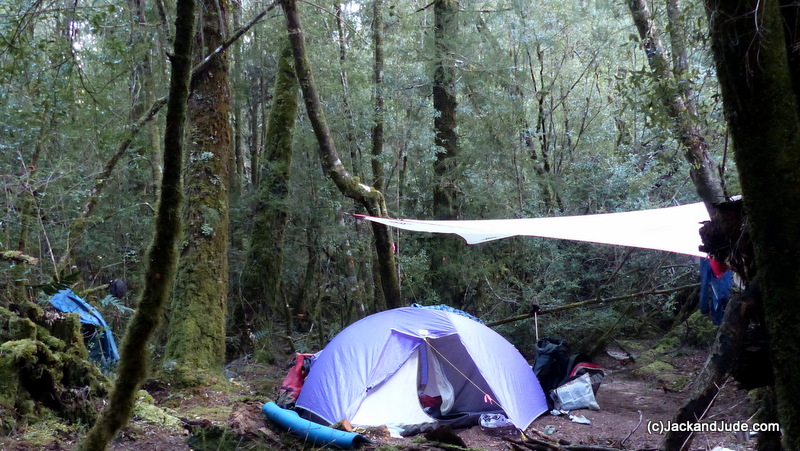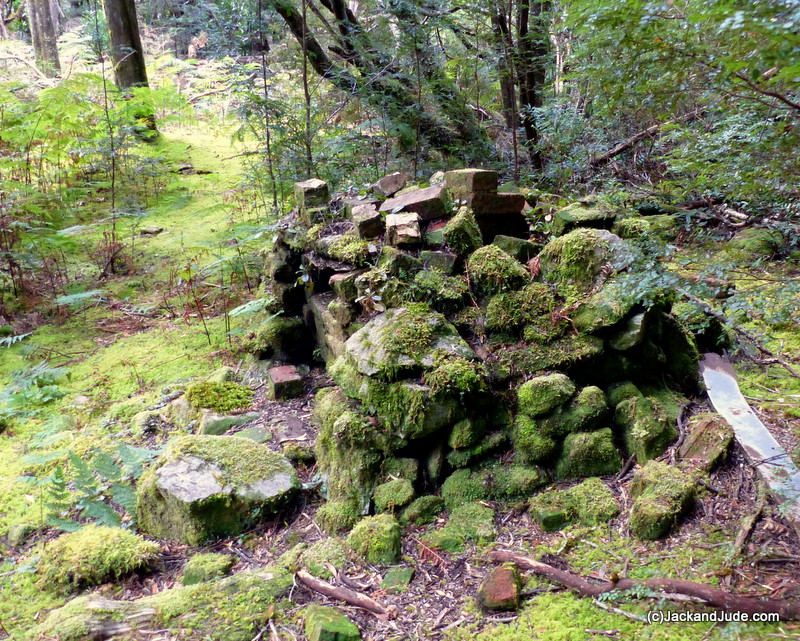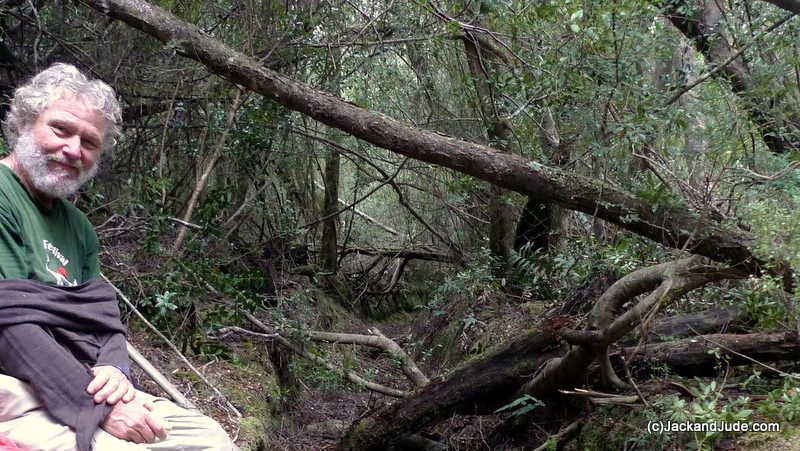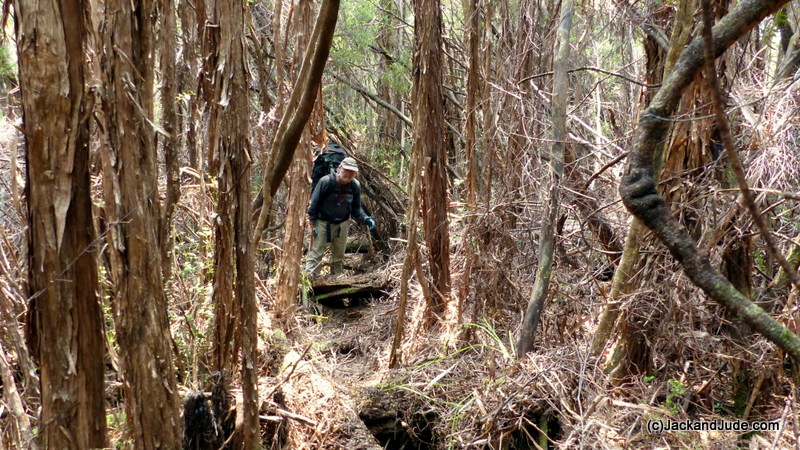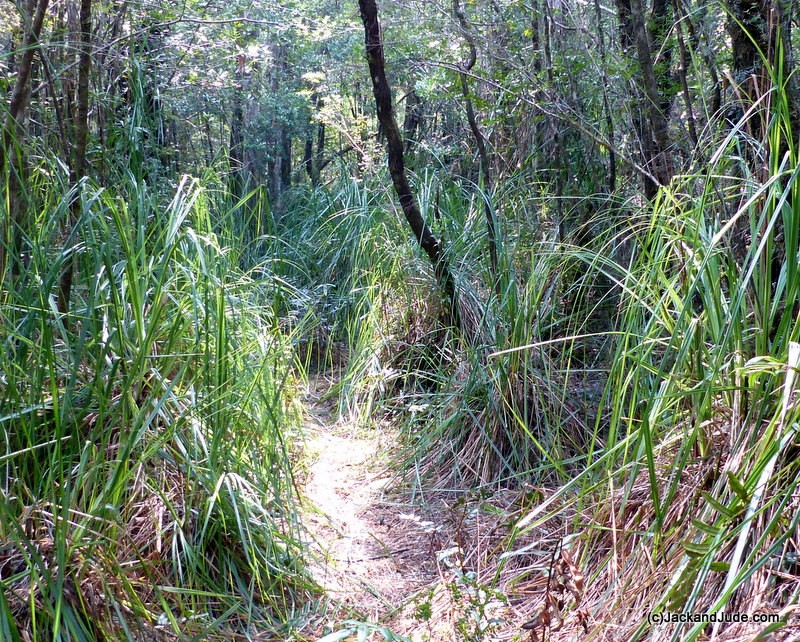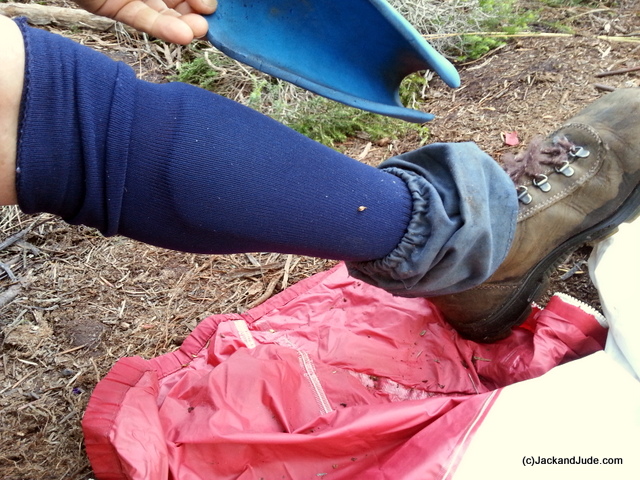Pain and Pleasure ~ April 2015
Oh my, we’re weary and stiff. Our feet sore. Our troublesome knees are swollen. You may remember our last note, posted as we lost contact with the outside world, said not to worry, that we’d be gone a few weeks, maybe longer. Well, that’s why you’ve not heard from us for over a month.
THE HUON WAY
The first part of the track nearest Sir John Falls was once used to haul Huon Pine logs from the immediate area and is indented by dragging those logs out with a metal skid under their front end. These valuable logs used to build many of Tasmania’s first ships, grow within a kilometre or so from the river’s edge, and the furrow they carved, called a shoe road, records much history. Today, contrary to an incorrect belief, many Huon Pines still flourish in the SW forests, and several trees over a thousand years old grow alongside this part of the track. There are also many hundreds, maybe even thousands, of small baby ones right beside the path. It’s a beautiful spectacle. Proof of the indomitable will of Earth to heal and survive.
The two-kilometre run of Shoe Road, which we’ve named The Huon Way, is now safe enough for schoolchildren to walk along. It’s quite easy-going, a charming walk in a park that will uplift the soul with the majesty of Earth. About two-thirds along is a suitable place to camp for those wanting to be immersed in the dark closed forest that borders these SW wild rivers. We dubbed it Camp Twin Pines after spending several nights there early last year. It’s a small open area with seasonal water nearby and next to two five-hundred-year-old Huon Pines.
A little further along the well-defined shoe road stands the last two Huon Pines stumps, large moss-covered stumps harvested perhaps sixty years ago. Beyond these, abruptly starts a forest of mature Manuka, tall and slender, close together with shedding bark that dangles in thin strips making them look like hairy poles. The Hydro track then meanders through this for another kilometre, all requiring a higher skill level to follow.
Back in the 1860s, the Charles Gould team would have cut a cart-wide track. The geologists and miners that followed him would have continued to maintain this by trimming regrowth and cutting away fallen trees lying across that track. The Piners did this too, as did the Hydro men. Users of the track maintained an open pathway about a cart width, a mere ribbon through what is a vast country of natural land. None of this ever endangered the whole by even a smidgen.
In the early ’80s, after the area became National Park, the Hydro men stopped coming, and this historical track, an essential part of our history, was left to be lost forever, consumed by Nature. And this magnificent tour of the wonders of SW Tasmania became merely a dashed line on old maps.
Our Interest
You may be wondering what our interest is in this. Well, isn’t it strange how some things get started? Early last year we wandered up to Sir John Falls wanting to know more about the Huon Piners after taking part in the filming of Two Men in a Punt, a Garry Kerr production. After seeing an iron shoe at an up-river camp, we wanted to see a shoe road, made when a team of horses dragged a log out of the forest. Goulds Landing once had a forestry officer’s house at the end of a shoe road, and not having visited it, we rowed Little Red from the jetty across the narrow gap where Cataract Creek enters the Gordon. This gap used to be spanned by the old jetty but now only the stumps are visible. Along that hillside, we found a track, somewhat overgrown and blocked by fallen trees. But after a bit of a scramble, we came upon a massive open area where, in yesteryear, supplies were stacked after being unloaded from coastal freighters moored alongside Goulds Landing. Metal angle and rotting timbers are all that remain of that jetty.
The Forestry House has long since been dismantled and towed downstream to Strahan – today some of its roofing iron protects the Morrison Mill in town, so only the two fire hearths remain a testimony to a past era.
Finding the shoe road was much harder than we’d imagined even though the expansive area was reasonably clear of shrubs and bushes. Crunching over a layer of fallen limbs filled with soft leaf litter we finally found a trace of the furrow under a tangled mess of tree fall comprising one massive tree head on top of a fallen giant that had taken down several smaller trees with it. Skirting this, the road became starkly evident – a furrow wide enough for three horses inline, worn in the earth to varying depths. In a straight line, it climbed the hillside but was soon blocked by another massive tangle of trees.
Back at Sir John Falls, we found that a school class had made a camp on the flats above the jetty, and a dozen students and teachers soon gathered alongside Banyandah, wanting to know more about life afloat. From them, we learned that they were on an annual orienteering course put on by Launceston High School and that they had paddled kayaks up from Heritage Landing after taking the ferry from Strahan. A great feat. So we told them about our day discovering the shoe road above Goulds Landing and like a swarm of bees got them humming with plans to make the same discovery.
Children Bind All Humanity
We don’t know how you feel, but we believe children bind all humanity. Be they Christian, Muslim, black, white, oriental, African, American, or Australian; Children are the common denominator. We want them to have a beautiful life and to have at least as much happiness as we’ve had, and we want them to experience as much of Earth as is possible. Hearing the excitement in their young voices got us thinking of how great it would be if the old shoe road were open and passable. Schoolchildren and ordinary folk alike would then have an opportunity to experience one of the most magnificent forests in the world. It would also allow people to see the many trees and shrubs that flourish in the wet climate found here. At the same time, walking the track would make create an opportunity to assess what our forefathers had to endure to eke out a living, bringing the unique Huon Pine to the greater world. It felt such a shame that this historical track had not been kept clear and we thought that a valuable asset had been lost. So, early the next morning, we went back and started clearing the dead branches that we could lift, which made better, safer access without having to look down or chance getting lost.
We returned day after day as a way of enjoying the great outdoors and a challenge to our bush skills, for the shoe road was quite difficult to find sometimes. After a half dozen sorties we left the forest and went back to town having strung pink tapes along about one kilometre of the track. We had made a start, and that meant next years orienteering class would more safely be able to penetrate that magnificent forest.
In town, an acquaintance had heard of our interest and came to us with a satellite photo showing what he thought might be one of the timber bridges built so long ago to cart supplies across some of the small creeks. Humm, it did lie on the magical dashed line representing the Hydro track on our topographical map, and it wasn’t that much further on from where we’d gotten. So, after taking on more supplies, we went back upriver for another stint of track finding.
After the stumps of the last two harvested Huon Pines, the indented shoe road finished, and every direction was looking the same. In addition to the danger of becoming lost, there are other dangers like Cutting Grass, or what we call Razor Grass. Long blades were growing in clumps up to two metres in height with razor-sharp serrated edges that easily cut arms, neck, eyes, and eyelids. We can testify to that.
As the terrain continued to rise, that broad band of Manuka gives way to larger trees of Eucalyptus. It becomes more open above, but underfoot it becomes a jumble of fallen trees in various stages of rot. In such a wet climate, Eucs don’t last long on the ground. Therefore, along the path of our pink ribbons are many fallen trees that must be climbed over. Many are slippery to walk along. Great care must be taken not to slip or put a leg down a hole between them. Otherwise, a broken bone might spoil your day by endangering your life and causing great inconvenience to your rescuers.
Surviving the Eucalyptus forest is marked by sighting a giant headless tree that may not survive many more winters. Beyond it, our path became even more challenging.
There grows here in Tasmania several plants that are quite challenging to forest travellers. Cutting Grass or Razor Grass is one. Horizontal another. It’s a strange plant that begins by growing vertical then under its weight bends horizontally to about shin height where along its length it sprouts new branches that grow vertically like a picket fence. Nearly impossible to penetrate unless you’re a double-jointed dwarf. Fortunately, this track has no horizontal along it. But there is another plant that’s even more insidious. It lies at the other end of the size scale. To those that know Tassie’s bush, nothing is more challenging, more draining of energy than Bauera. The mere mention of its name makes Tassie’s bushmen shudder. Watch this short vid for a better idea.
HD format of Bauera – The Bushman’s Curse from JACKandJUDE
Bauera is a pretty plant with a multitude of tiny bright green leaves along its stems, which grow like a nest of tangled snakes, around and through one another, branching into two that then splits to four, then eight, weaving a mass higher than man, often high up into trees. It loves to grow around and over other plants. It enjoys weaving up an entire hillside with a net of cables that start at its base with something like 12mm rebar before branching into many more about the diameter of a pencil and then heaps more about the size of stout wire. Bauera is not only a daunting, draining task to penetrate, it’s also a bitch to pass over after it has been flattened because it always catches a boot, or a strand just seems to jump up to act as a barrier.
From the headless Euc that may not last another winter, there is a half kilometre of Bauera intertwined through and over fallen trees. No telling how long this passage will stay open. A few wet seasons will probably see our pink ribbons consumed by the green glory of Nature unless more folk walk our path. But once through this last barrier, we arrived at a beautiful, open to the sky, bowl of buttongrass. Our mysterious bridge lay just over the next ridge.
Each of these forays was taking longer and longer to return home, and we found that up to four hours of every outing would be taken up with travel along a path we’d already marked. So we took our tent up to Camp Twin Pines for a last effort at finding this mysterious bridge. Third time lucky we hoped.
By this time it was late-April and the days were getting shorter, the nights colder, the climate wetter, and our hobby demanding more true grit. But by this time we had fallen in love with the forests. We’d come to know the massive old Huon Pines, gnarly and grand, standing off track, and massive ancient myrtles that have such tiny colourful leaves, and cheesewood trees looking like tall creamy Swiss cheese pocked with small round marks, and blackwoods, and leatherwoods that in summer are transformed by a filigree of large white blossoms. The forest can be one of the quietest places, perfect for contemplation, but of course, the forest birds woke us each morning and kept us company during our day, and they sang melodies in the evening when the sky grew golden.
Third time lucky proved to be just another pipe dream. When we entered that small thick creek, we found nothing but beautiful lush green vegetation and a tiny flow of water. Oh well, it had been fun and kept us fit, and had provided us with a great adventure. So we packed our kitbags and went home for the winter.

